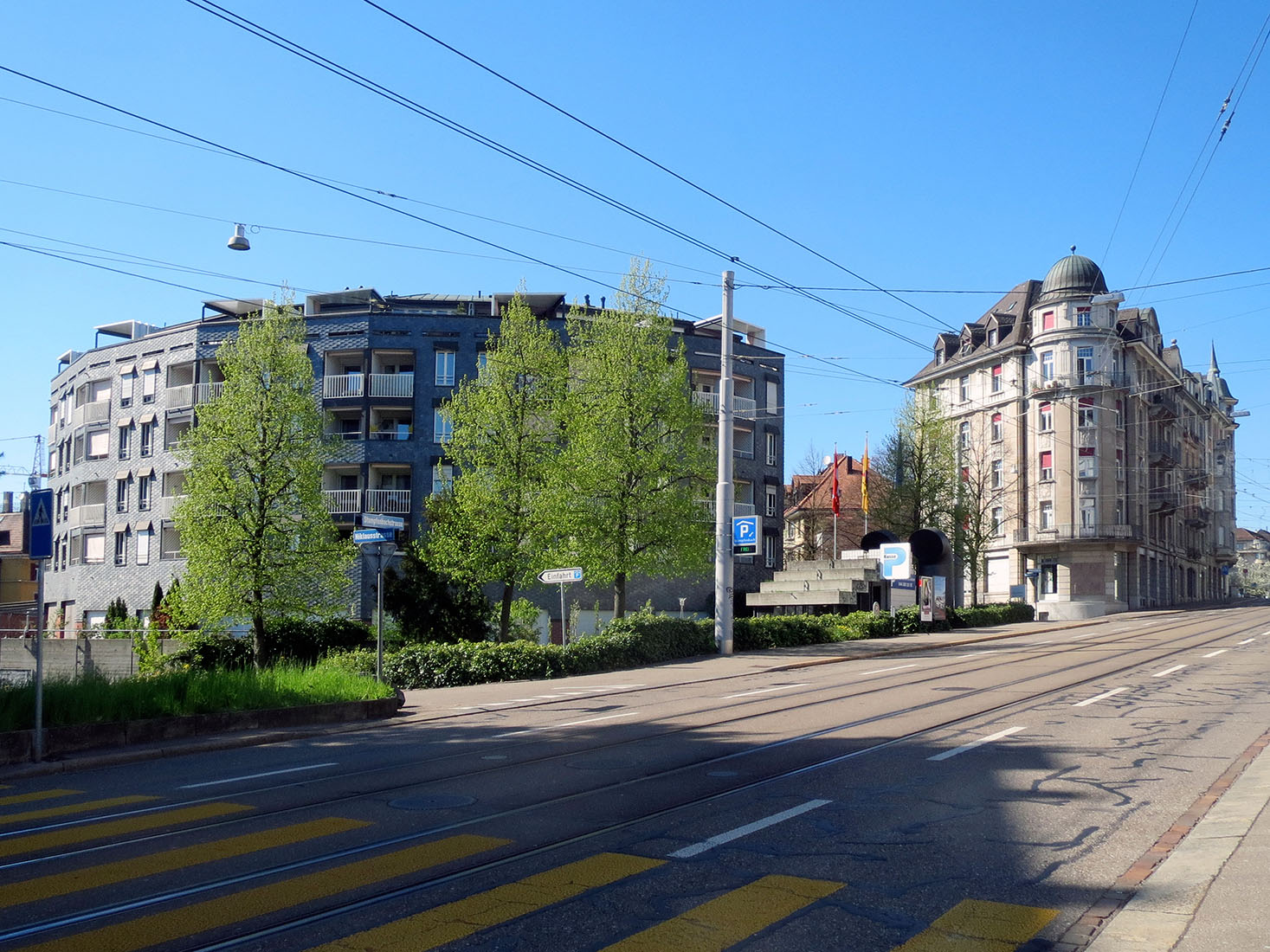 |
 |
 |
 |

Home for Elderly People Stampfenbach
Lindenbachstrasse 1, Zürich
1976-1988
In his work as an aesthetic consultant for the southern portal of the inner-city Milchbuck motorway feeder, Ernst Gisel suggested to cover again
the surface building site after the construction of the tunnel. Otherwise there would have been generated a deep cut into city quarter.
According to the idea of Ernst Gisel the resulting building ground should be used for a much needed retirement home in this city district.
A visible indication of this situation is the exhaust chimney of the tunnel, which is horizontally banded with blue glazed tiles.
Also designed by Ernst Gisel is the traffic control center Letten (1978 - 1983). This closed circular building with a courtyard is located closer
to the tunnel entrance on the Nordstrasse and was extended in 1992/93. Within the tunnel covering is integrated an underground parking garage
and utility rooms of the retirment home.
The retirement home is a striking semicircular solitaire building with two very differently shaped main elevations.
The entrance side of the building is plastically shaped and seems to absorb the grown urban fabric. In contrast,
the south side of the building shows a pure volume sitting on the tunnel covering, which is designed as a landscaped park.
The fan-shaped floor plan ensures the view of the city and partly to the distant mountains from rooms - all of which are provided with a loggia.
A new feature in this retirement home is the operating form as a so-called group system. The four upper floors each form an almost autonomous group out of 22 retirees.
Each group shares its facilities and has the possibility to have their melas in a private dining room with a small kitchen on their level.
Meals are prepared on the ground floor in a canteen kitchen. The common rooms on the ground floor, there is a large hall for events
and a public cafeteria, provide opportunities for encounters.
The building is constructad as a solid structure. Reinforced concrete is used for load-bearing walls and the non-load-bearing walls
are made of brick. The cladding of the structure with clinker on the ground floor and with broken natural slate on the upper floors
differentiates the construction additionaly in respect to the environment.
In 2006, there were made minor modifications, which concerned the rooms have on the first floor.
There was made a station for dementia, a station for the nursing staff and an especially equipped room for the chronically ill.
The former staff apartment on the set back fifth floor was converted into separate lofts for elderly with care and restaurant services.
This work was carried out by Ernst Gisel in collaboration with Tony Güntensperger of Zurich. Aligned with the rhythm of the façade grid,
new metal awnings on the roof terraces give the building a new character. The formerly straight building termination is broken up by the new roof crown.
the surface building site after the construction of the tunnel. Otherwise there would have been generated a deep cut into city quarter.
According to the idea of Ernst Gisel the resulting building ground should be used for a much needed retirement home in this city district.
A visible indication of this situation is the exhaust chimney of the tunnel, which is horizontally banded with blue glazed tiles.
Also designed by Ernst Gisel is the traffic control center Letten (1978 - 1983). This closed circular building with a courtyard is located closer
to the tunnel entrance on the Nordstrasse and was extended in 1992/93. Within the tunnel covering is integrated an underground parking garage
and utility rooms of the retirment home.
The retirement home is a striking semicircular solitaire building with two very differently shaped main elevations.
The entrance side of the building is plastically shaped and seems to absorb the grown urban fabric. In contrast,
the south side of the building shows a pure volume sitting on the tunnel covering, which is designed as a landscaped park.
The fan-shaped floor plan ensures the view of the city and partly to the distant mountains from rooms - all of which are provided with a loggia.
A new feature in this retirement home is the operating form as a so-called group system. The four upper floors each form an almost autonomous group out of 22 retirees.
Each group shares its facilities and has the possibility to have their melas in a private dining room with a small kitchen on their level.
Meals are prepared on the ground floor in a canteen kitchen. The common rooms on the ground floor, there is a large hall for events
and a public cafeteria, provide opportunities for encounters.
The building is constructad as a solid structure. Reinforced concrete is used for load-bearing walls and the non-load-bearing walls
are made of brick. The cladding of the structure with clinker on the ground floor and with broken natural slate on the upper floors
differentiates the construction additionaly in respect to the environment.
In 2006, there were made minor modifications, which concerned the rooms have on the first floor.
There was made a station for dementia, a station for the nursing staff and an especially equipped room for the chronically ill.
The former staff apartment on the set back fifth floor was converted into separate lofts for elderly with care and restaurant services.
This work was carried out by Ernst Gisel in collaboration with Tony Güntensperger of Zurich. Aligned with the rhythm of the façade grid,
new metal awnings on the roof terraces give the building a new character. The formerly straight building termination is broken up by the new roof crown.
